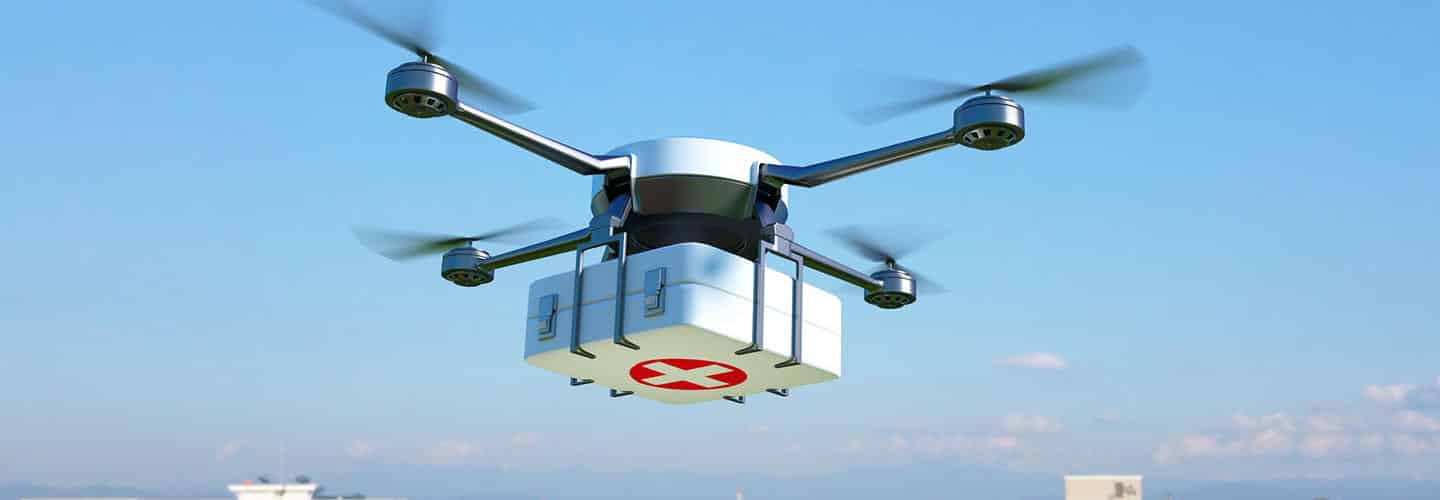When they were first being developed, drones were primarily seen as a cool toy that was just useful for photographers and tech enthusiasts. However, more and more people are beginning to realize that drones are quite useful. They are now used for a variety of helpful services like product delivery and surveillance. The convenience and speed of drones make them ideal for a lot of emergency situations, and many crisis response experts are starting to consider the idea of outfitting drones for life-saving purposes. One day, drones might perform these important, life-saving tasks.
Guiding Bystanders Through First Aid Responses
Medical emergency drones may be able to get fast help to those suffering from a health condition or accident. Since drones can fly directly to any location, they often arrive much quicker than an ambulance would.

Until the healthcare professionals can come, a drone equipped with video and speakers can let a doctor speak straight through the drone. This capability could be used to instruct bystanders in the safest way to help the victim. The potential to have guided instructions for stopping blood loss, assisting with choking, or administering an adrenaline shot could save countless lives.
Reducing Police Pursuits
A surprisingly deadly part of modern life is simply police pursuing suspects. A 2007 study discovered that the reckless driving in police pursuits kills an average of 232 bystanders and police officers each year. Many of these dangerous wrecks happen because police officers are rushing to keep an eye on a suspect before the suspected criminal can flee.
Police departments have some helicopters to assist with surveillance, but these are expensive to operate and purchase. Cost efficient drones could one day be an excellent way for police officers to get air support. Instead of driving recklessly to keep up with a suspect, police could monitor them with a drone and just direct the nearest officer to intercept with the suspect.
Providing Defibrillators to Cardiac Arrest Victims
For many people undergoing cardiac arrest, a defibrillator is the only way to restart their heart. Time is essential to saving the life of a cardiac arrest victim, but in many cases, defibrillators are too far away for a person to get in time.
Drones could change this and make the process far easier. In the future, a drone equipped with artificial intelligence could deliver a defibrillator straight to the victim, and a trained medical professional can speak to a bystander to guide them through the defibrillation process. Though they are not in the air yet, prototypes are already being developed. Dutch engineering graduate Alec Momont uses this video to demonstrate how a drone defibrillator could work.
Dispatching Medical Supplies
Powerful drones can carry loads that weigh over 40 pounds, so they can be very useful for medical deliveries during emergencies. Simple things like bandages to stop bleeding, asthma inhalers for an allergy attack, or aspirin to thin the blood during a heart attack, could do an amazing job of saving lives.

Since it takes ambulances a while to travel through crowded traffic along roads, drones could zip ahead to provide the supplies needed to start treating a person while they wait on the ambulance. Getting medical supplies through drones would be especially important during active live shootings, snowstorms, and other situations where a human responder would be in danger if they traveled to the area.
Delivering Antivenom
According to the World Health Organization, venomous bites affect roughly 2.7 million people each year. Without prompt administration of antivenom, people often die from the paralysis that stops breathing or bleeding disorders that causes hemorrhages.
A big challenge in prompt venom administration is currently the difficulty of getting antivenom. Only a few facilities have the right equipment and materials to produce antivenom, and these are often far away from the rural and agricultural regions where people need the venom. The speed and low cost of drone delivery could help to ensure that antivenom gets to people in need in time to save them.
Discovering lost people
Drones are already being used for this life-saving purpose around the world. According to DJI, a Chinese drone manufacturer, 59 lives have already been saved through drone surveillance. In any situation where a search and rescue mission must be done, a drone can be extremely helpful.
It covers rough terrain far quicker than a human rescuer, and drones can be used to check for lost people in blizzards and other situations where it would be hazardous to risk more rescuers without knowing where the victim is. Each year, thousands of people get into tricky situations when hiking, climbing, and boating. Drones that can cover large regions quickly, spot survivors, and provide GPS information on the survivor’s locations could save many people.
Supplying Food and Water After Disasters
After hurricanes, tornadoes, and other natural disasters, local infrastructure is often destroyed. This is one of the reasons that so many lives are lost following a disaster. Without roads to reach victims of a natural disaster, rescuers struggle to bring in the food, water, and medicine that people need.
For example, Hurricane Katrina was made far worse when residents of New Orleans were crowded in the Superdome without enough food and water. Drones’ abilities to travel over rough ground, around uprooted trees and past downed electrical wires make them ideal for providing disaster relief. Being able to promptly supply essentials to disaster victims could keep situations from being as bad.
Helping Drowning People
On beaches all around the world, lifeguards struggle to get to drowning people in time. Even though they can quickly identify a person in distress, by the time they swim past rows of oncoming waves and reach the person, it may be too late. One potential use for drones will be quickly reaching swimmers in trouble and drop life jackets or flotation devices to them until a lifeguard can reach the person.
There has already been one case of a drone preventing drowning in Australia, where an experimental project used a drone to deliver a flotation device to save people caught in nine-foot waves. If this concept is expanded to other high-risk beaches, it may prove very helpful.
Author’s Bio:
Jake Carter is a drone enthusiast and writer at RC Hobby Review follow him on Twitter @RCHobbyReview or Facebook @RCHOBBYREVIEW













1 Comment